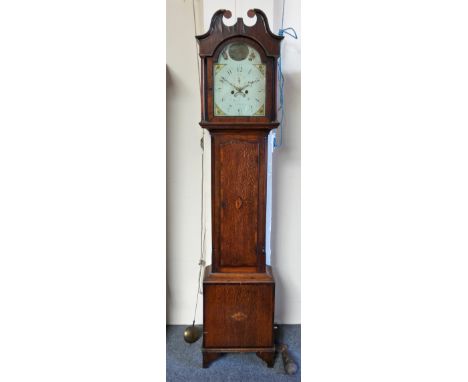We found 44425 price guide item(s) matching your search
There are 44425 lots that match your search criteria. Subscribe now to get instant access to the full price guide service.
Click here to subscribe- List
- Grid
-
44425 item(s)/page
A 19th Century oak and inlaid cased longcase clock, the eight day movement with arch dial depicting a huntsman and hounds in a landscape over a chapter ring with Roman numerals enclosing a subsidiary seconds dial and date aperture by J Bennett of Kirton Lindsay size approx. 47cm long x 200cm high x 23cm deep. Dial 33cm wide
An XVIII Century Mahogany Eight-Day Longcase Clock, the circular brass dial with Roman numerals and two subsidiary dials inscribed "Hill Sheffield", hood with arched pediment (no door), trunk with long door and reeded pilasters, the base with canted corners and applied moulding, on ogee feet.
A 19th Century flame mahogany North East Country longcase clock, the 13" painted arch dial with rocking galleon and marked for S. Bailey, Newcastle with subsidiary seconds and date dials, the original case with shaped door and flanking turned columns to trunk, with eight day bell striking movement
A Large Exhibition Type Longcase or 'Grandfather' Clock with a three train movement on eight chiming bells, supported by three large brass weights of varying sizes, playing Westminster and Whittington chimes. Subsidiary dials to the arched brass dial with silent and chimes display dial; the brass dial fitted with cast ormolu mounts to back corner, silvered chapter rings to the dial, maker or retailers name to the face, Thomas Armstrong and brothers, Manchester. Impressive mahogany case profusely inlaid with satinwood and various coloured exotic woods, with an Adams type urn to the central panel of the door; inlaid swags to the base, supported by shaped bracket feet. The hood with finely carved rosette roundels to the scrolls, with a central finial, fret work sides to the hood and finely matched Corinthian columns with capitals to both the case trunk and hood, 90'' high, 18'' wide, 12'' deep.
An 18th century George II, 1740 brass faced longcase clock by Edward Spring. The brass face with name and date upper centre having roman numeral chapter ring with fleur de lys decoration, faceted hands and gilt metal pierced and lattice spandrels to the corners. All set within an oak case with trunk and hood. Inset 30hour movement striking on a bell. Measures 208cm x 56cm x 22cm
A 19th century Dutch longcase clock, the walnut case with marquetry inlay, the brass face with musical movement and silvered dial set with Roman numerals, the hood with blind fret decoration, height 239cm.Additional InformationCase has general surface wear throughout, light scratches, very minor chipping to veneer, wear and tear, minor cracking to veneer, re-polishing/re-waxing around base.
WEIR & SONS OF NOTTINGHAM; a mahogany cased longcase clock, the brass face with silvered dial, with Roman numerals and musical movement, the case enclosing nine tubular bells, height 240cm.Additional InformationThe clock was wound with a couple of turns yesterday and it began to tick for around five minutes, although was not chiming and has since stopped ticking.
GEORGE HONEYBONE OF FAIRFORD; an oak cased thirty hour longcase clock, the painted dial with Roman numerals, height 196cm.Additional InformationReplacement lock mechanism to the interior of the case, craquelure to dial, wear to paint on dial, possible replacement door to case, pendulum holder looks to be re-soldered, complete with pendulum and weight.
Jones & Taylor, Newport - early 19th century mahogany longcase clock, the arched dial with moon roller with calibrated date arc over, the circular dial with black Roman numerals, seconds indicator, calendar aperture, 8-day movement striking on a bell, the case with barley twist pilasters to the hood and trunk, line inlaid detail throughout (lacking finials), complete with two weights and pendulum, 210cm tall
18th Century oak and mahogany banded longcase thirty hour clock by Jackson of Gainsborough, 30cm brass dial with pierced spandrels and calendar aperture to movement striking on a bell, contained in case with swan neck pediment, the trunk with Vitruvian scroll inlay, 202cm high, pendulum damaged, shrinkage split to base
An early 19th Century eight day mahogany and oak longcase clock, by Smith and Sons, Walton-on-Trent, the hood with a swan neck pediment, the glazed door set between turned columns, the painted dial with black Roman numerals and subsidiary dial, the door with a triple Gothic shaped arch, with two weights and pendulum. 223cm H x 61cm W x 26cm D
Peter Jacquet, London, a George III mahogany eight day longcase clock, circa 1770, pagoda pediment with fretwork panel, brass flame finials, reeded corinthian columns with brass inserts, arched brass dial with silvered chapter ring and subsidiary seconds dial and date aperture, chime/silent subsidiary dial in the arch, urn and eagle spandrels, arched trunk door, height 222cm, (two weights, pendulum and key)
A George III mahogany 8-day longcase clock by Joseph Brown of Worcester (1767-1796), circa 1780, arch moulded pediment above a silver chaptered ring, brass dial, roman numerals, Arabic outer-track numerals, inlay inscription of the makers name, fluted pillars with brass quarter, moulded panel door, raised on bracket feet, weights and pendulum. 207cm H
A William III figured walnut 8-day longcase clock by Richard Baker of London, circa 1690, moulded cornice with floral fretwork, above barley twist columns, 10inch brass dial with silvered roman numeral chapter ring, subsidiary seconds, date aperture, cherub face mounted spandrels, signed engraving of Richard Baker, London, cushioned moulded panel door, moulded skirt on a plinth base. Weights, pendulum and key. 203cm H x 45cm W x 26cm DNote: Richard Baker is recorded in Loomes, Brian The Early CLOCKMAKERS of Great Britain as being apprenticed through the Blacksmiths` Company to John Chatfield before transferring to Richard Browne in 1683.He gained his Freedom of the Clockmakers` Company by redemption by order of the Lord Mayer in 1685. He is described as a `Great Clockmaker` and took on many apprentices including Peter Garon in 1687 for which he was fined by the Clockmakers` Company as Garon Clockmakers.
A George III oak and mahogany longcase 8 day clock by J Holliwell of Derby, globe finial on swan neck pediment hood, arch top with corner rose spandrels, roman numerals, date aperture, subsidiary seconds dial, flanked by turned flute pillars with moulded brass ends, satinwood strung, moulded panel door, raised bracket feet. 225cm H x 52cm W x 25cm D
A George III oak and mahogany inlaid 8-day longcase clock, circa 1780, three turned globe shape brass finials, swan neck scrolling pediment with brass floral inlay, above a square glazed door and square painted and brass inlay dial, Roman numerals, subsidiary second dial, moulded panel trunk with fluted pillars, raised on a platform base. 205cm H x 52cm W x 25cm
A George II Staffordshire oak longcase clock, square brass dial 11in (27.5cm) dial with Roman and Arabic chapters, cast brass spandrels, matted centre, pierced hands, date aperture,signed Redshaw/Newcastle, 30 hour movement, countwheel striking on a bell, hood with caddy top with wide cornice supported on turned columns, rectangular crossbanded door to waist with boxwood and ebony stringing, skirted plinth base, 85.5 in (220cm) high, weight and pendulum with brass bob.John Redshaw of Newcastle-under-Lyme was working from the 1740s to the 1760s before being succeeded by his son Daniel, who had taken over by 1771.
A George II walnut longcase clock, 30cm arched brass dial with silvered chapter ring inscribed Edward Brooks, Derby, the arch with roundel inscribed Tempus Fugit, Roman and Arabic numerals, subsidiary seconds dial, date aperture, twin winding holes, 8-day movement striking on a bell, the case with moulded outswept cornice, Doric columns, crossbanded rectangular door to waist, outlined with feather banding, plinth foot, 229cm high, c.1740
A George III Lancashire mahogany longcase clock, 33.5cm arched brass dial, inscribed William Kirk, Stockport, Roman and Arabic numerals, rolling moon phase to arch, subsidiary seconds and calendar dials, twin winding holes, eight-day movement striking on a bell, the case in the manner of Gillow of Lancaster, brass ball and spire finials, lofty swan neck pediment, above a frieze carved with blind fretwork, shaped rectangular door to waist, flanked by brass capped stop-fluted quarter columns and rusticated angles, ogee bracket feet, 233cm high, c.1785***Please note that this lot may have been affected by flood water***
A George III mahogany longcase clock, 31cm arched silvered dial inscribed Robert Smith, London, Roman and Arabic numerals, Strike/Silent to arch to arch, subsidiary seconds and calendar dials, twin winding holes, eight day movement striking on a bell, lofty pagoda hood, arched rectangular door to waist flanked by brass mounted Doric stop-fluted columns and quarter columns, plinth base, 233cm high, c.1770
A George III oak and mahogany longcase clock, 31cm square brass dial inscribed Cooper, Derby, Roman and Arabic numerals, subsidiary seconds and calendar dials, twin winding holes, 8-day movement striking on a bell, the case with swan neck pediment, fluted square pillars and angles, shaped rectangular door to waist, inlaid with a roundel, outlined throughout with boxwood and ebony stringing, canted base with bracket feet, 212cm high
A George III oak longcase clock, arched painted 12in (30.5cm) dial signed E. Marriott/Downham in arch, Roman and Arabic chapter subsidiary seconds dial and date aperture, gilt spandrels, pierced hands, eight day movement striking on a bell, carved hood with lofty swan-neck pediment centered by a brass ball and spire finial with modillion cornice supported on brass furnished Doric columns, luted quarter columns to trunk, shaped door, brass keyhole escutcheon, panelled base, bracket feet, 90.5in ( 226cm) high.Erasmus Marriott was working at Downham Market, 1780/1800.
A George III Scottish oak longcase clock, 30cm arched painted dial inscribed Wm Gerrard, Turriff, Roman numerals, the arch painted in the Chinoiserie taste with a Chinese figure, subsidiary seconds dial, twin winding holes, 8-day movement striking on a bell, the case with swan neck pediment, arched rectangular door to waist, flanked by spirally fluted quarter-columns, plinth base, 212cm high, c.1820
A George III Welsh oak longcase clock, 31cm arched painted dial inscribed W.Williams, Pontypool, painted to the arch with maritime scene, Roman numerals, subsidiary seconds dial, date aperture, twin winding holes, 8-day movement striking on a bell, the hood with eagle, ball and spire finials, shaped rectangular door to waist flanked by reeded quarter columns, shaped skirted base, bracket feet, 235cm high, c.1810
A GEORGE III MAHOGANY AND INLAID EIGHT DAY LONGCASE CLOCK, the hood with swan neck pediment flanked by fluted columns, distressed and dismantled painted arched dial/movement with automaton movement, Arabic numerals with subsidiary date aperture and seconds dial, dial diameter 32cm, height 238cm (sd, losses) (two weights, winding keys, pendulum)
An early 19th century oak longcase clock by Thomas Brass, Guildford, H.220cm Condition: Case looks to have been restored and repolished many years ago, is of mid dark brown tone but now a little tired and in need of some attention, arch to the top has two pronounced splits in the moulding, signs of old repair to the lower right hinge of the hood door, dial oxidised but otherwise looks original, movement complete but not tested for timekeeping, trunk door has dropped a little and now has two keyholes, the original hole has a brass escutcheon but missing lock, a later lock has been added above with a cut escutcheon but no key, comes with brass faced pendulum, one brass cased weight and one cast iron weight, box base a little faded but complete.
-
44425 item(s)/page




























































